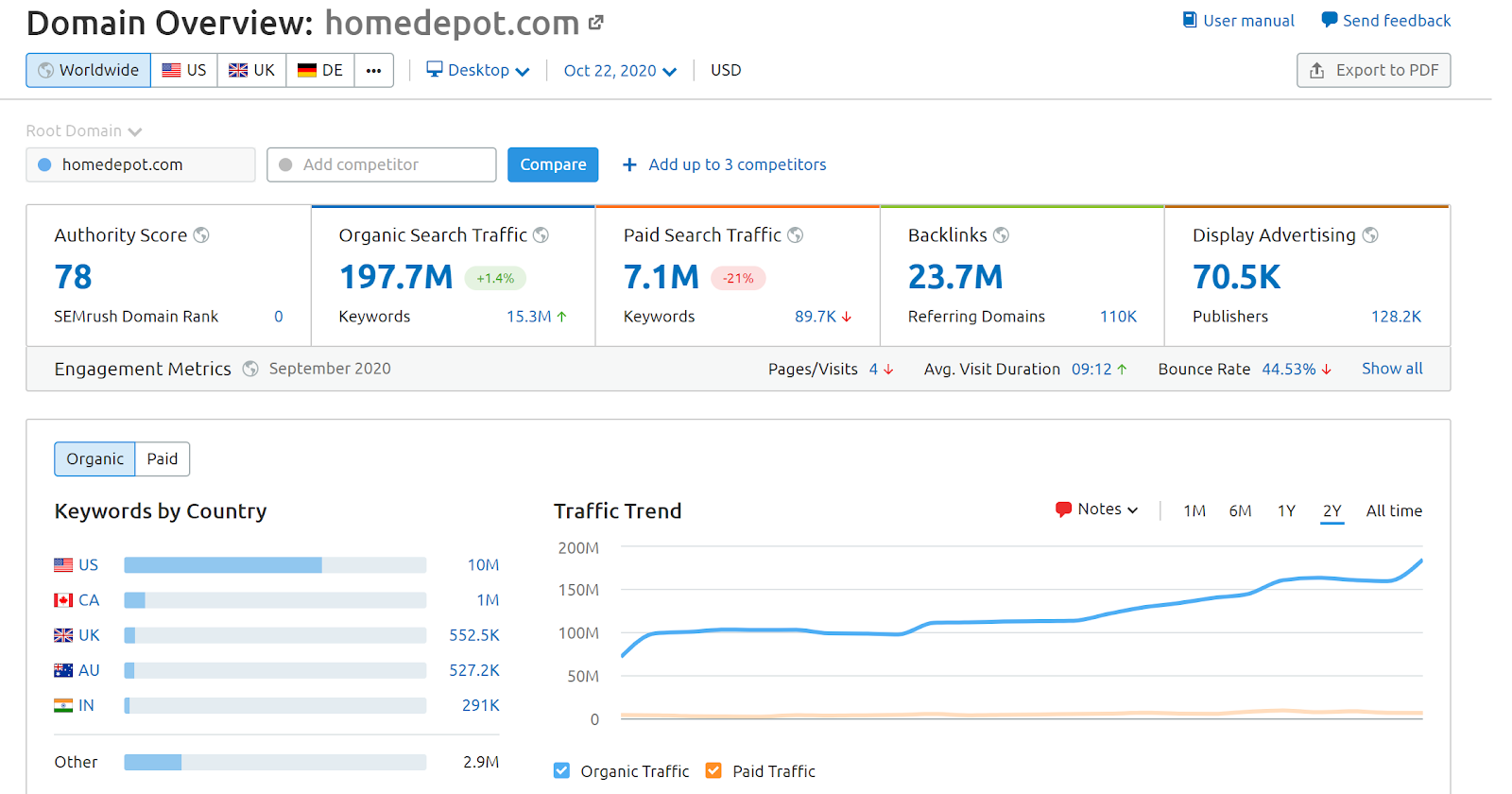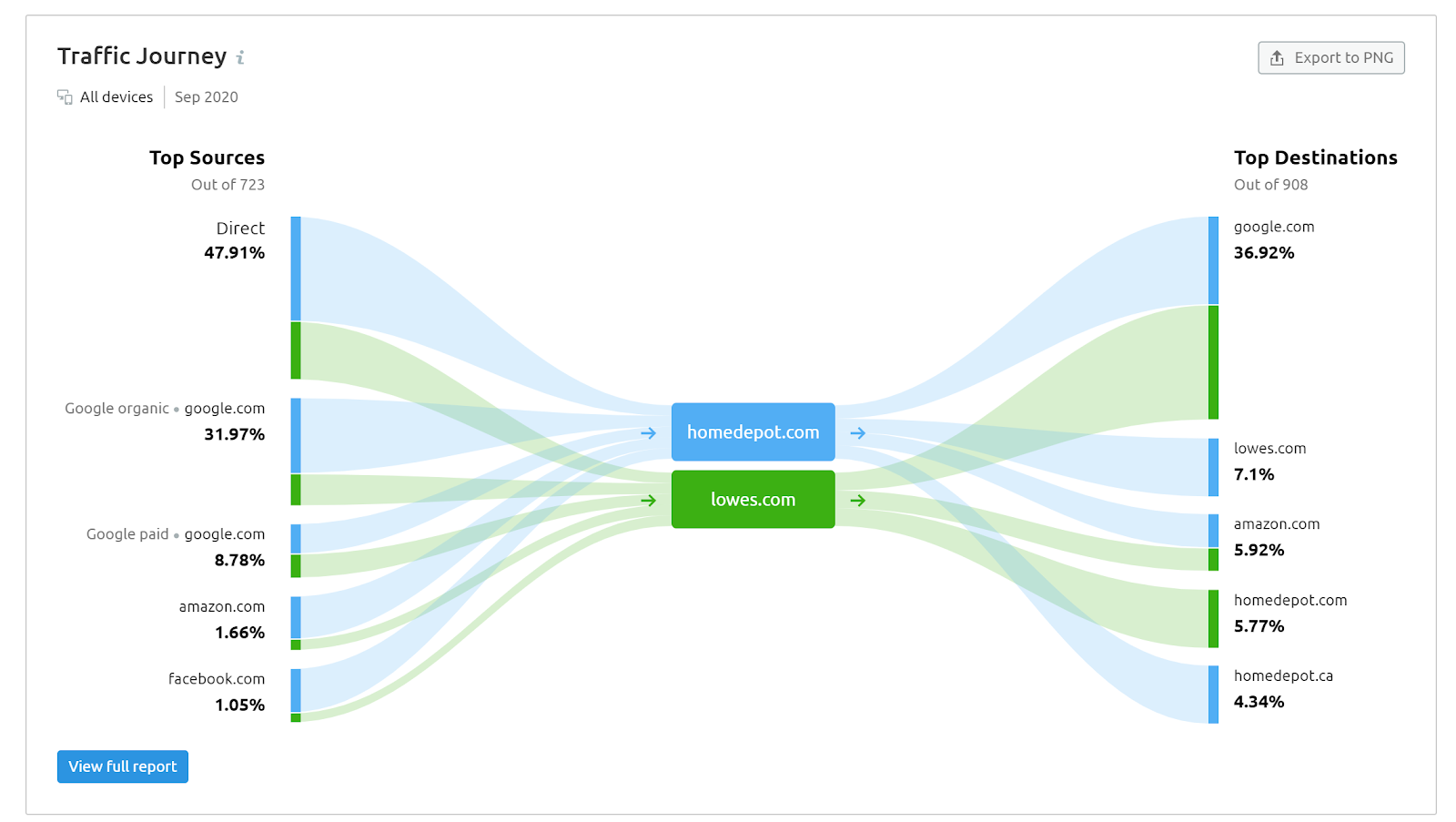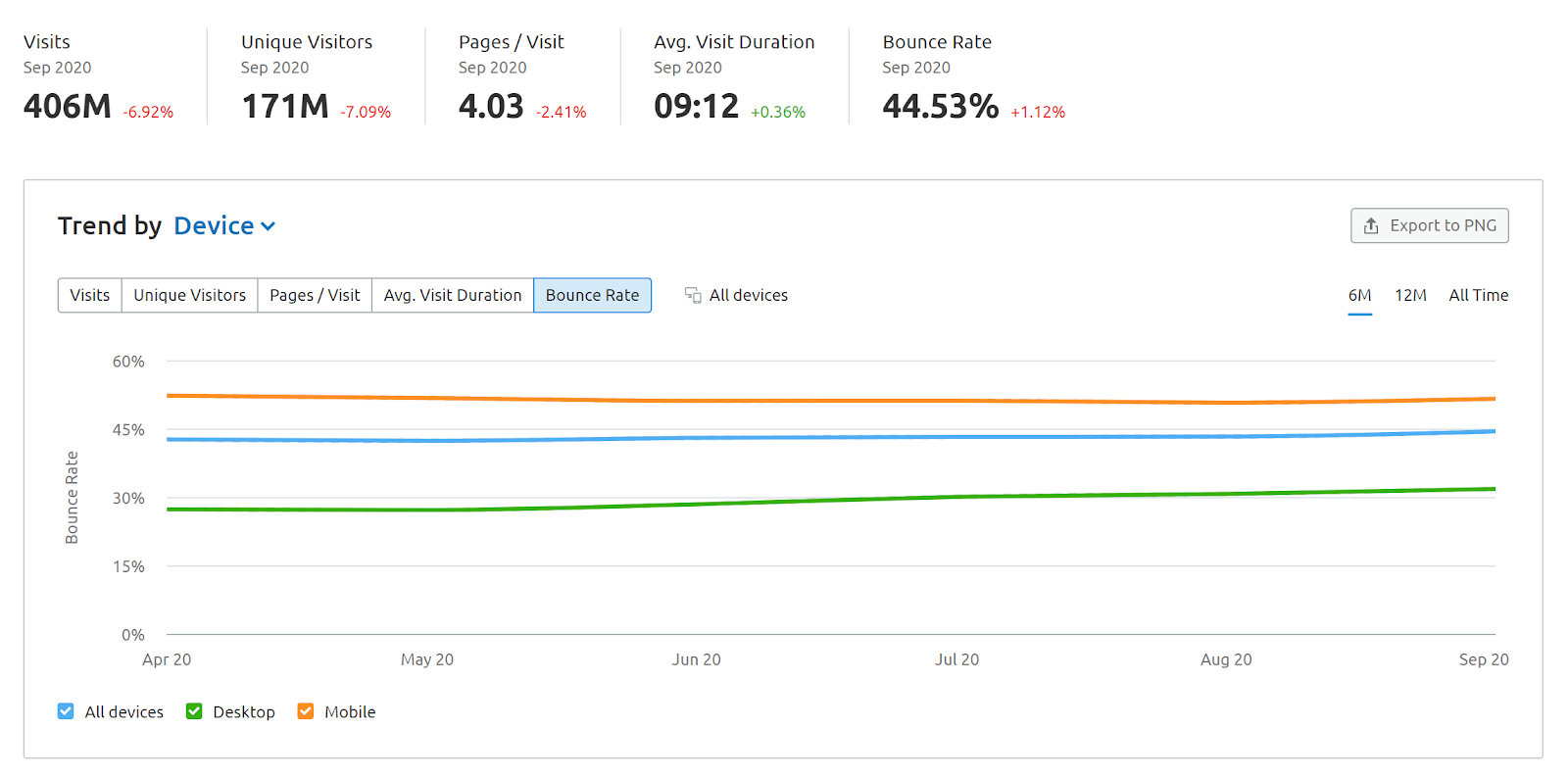Search engine optimization ( SEO) is the process of optimizing your webpages and content to rank high on a search engine. Ideally, you want your content at the top of a search engine’s results for keywords relevant to your product or services. This is why SEO is also the practice of attracting quality traffic to your website.
Whether you’re a freelance photographer or party supplier developing an e-commerce site, having a digital presence is an essential component of your inbound marketing strategy. Hence, implementing an effective SEO strategy is a strong start to boosting your website’s visibility, growing your organic traffic, and attracting new customers.
In our State of Content Marketing Report, we’ve established that SEO is still one of the most efficient digital marketing tactics. But having an SEO strategy and implementing it is only the first step. You need to keep tracking the results, as well. In this guide, we’ll cover the basic metrics that marketers can use to measure SEO performance and results.
Below, we’ll take a closer look at how you can measure your SEO results, specifically:
How Do You Measure SEO? Organic Traffic Keyword Ranking SERP Visibility Click-Through Rate Bounce Rate Website Authority Over Time Backlinks Page Speed Time Spent on Page Conversion Rate How Long Does It Take to See SEO Results? Learn How to Track SEO Performance TodayHow Do You Measure SEO?
If you’ve spent at least five minutes in the SEO world, you’ve probably heard the adage, “what you measure, you move.” This means that knowing your numbers is the first step in evaluating the performance of your SEO strategy.
There are hundreds of metrics you can track. Google uses over 200 ranking factors in its algorithm. But it’s best to stay focused on a few to start. Establish which metrics are the most critical for your business and track those metrics regularly.

Organic Traffic
When searchers type a question, word, or string of words into a search engine, they will get a set of results showing the ads and pages related to the search query. Organic traffic is the number of visitors your site generates from people clicking on your webpages when they come up from search engine results.
Organic search traffic is what you want for your website because it’s targeted. The person is looking for something specific, and if you can provide a solution, you’ll gain a new subscriber or customer. It’s also an effective indicator of the overall progress of your SEO strategy. Improvement in organic search results means your website’s visibility through keyword ranking has gone up.
If you want a comprehensive view of your website against your competitors’ traffic sources, consider our Domain Overview and Traffic Analytics tools. Both can help you better understand your organic traffic and how your audience is visiting your site.
Start with the domain overview, where you’ll get a high-level look at your traffic over time, including a breakdown of organic versus paid traffic. You can look at up to five competing domains.

From there, you can use traffic analytics to get a closer look at your traffic, including total visits and traffic sources (e.g., direct, referral, paid, social, and search). We also provide a unique traffic journey view that lets you see where your traffic is coming from and where it goes once it leaves your site (which can help you identify potential competitors).

Keyword Ranking
A keyword is a term that encompasses anything searched on a search engine. A single word or phrase is considered a keyword if it produces a results page on Google or any other search engine. To see results with this metric, your website and content need to be optimized to rank on top of search engines’ results for specific keywords and long-tail keywords.
A simple way to track your Google ranking for keywords related to your business or products is to do a Google search. The results will show you where your website ranks for said competitive keywords. The ultimate goal is to get on the first page and as close to the top of Google as possible, considering more than 25% of people click on the first Google search result.
To better understand your keyword performance and discover new relevant searches, you’ll want to conduct a keyword gap analysis. With up to five competing URLs, we can help you identify which keywords you’re ranking strongly for, keywords where you’re weak, and untapped ones where your competitors are earning search engine rankings, but there’s some potential for your domain.
SERP Visibility
For every query, Google produces an outcome or a search engine results page (SERP). These outcomes consist of organic results, ads, and SERP features. Examples of SERP features include featured snippets (instant answer), knowledge panels, and image packs.
Search engine visibility measures how many people see your website in the search results, which could be affected by the authority of the SERP features. But overall, this metric gives you a bird’s eye view of your SEO progress.
You can easily check your website’s visibility through the Position Tracking Tool of the SEO toolkit. For instance, we offer a featured snippet feature to identify the opportunities to rank for featured snippets for specific keywords and get insight into what the current featured snippet looks like to help you outline your content.

Click-Through Rate
The click-through rate (CTR) represents the percentage of users who clicked on your website from the SERP. For example, your CTR is 10% if your site appeared on a results page 100 times in a week, and 10 people clicked on it. Use this metric as a barometer of how effective your title tags and meta descriptions are in attracting users' attention.
Don’t be discouraged if you see low numbers in this metric; it just means you need to optimize your meta descriptions, titles, URLs and try to acquire some featured snippets that are relevant to your business. The average click rate for the first position in Google is 28.5%. So, boosting your keyword ranking can also increase your click-through rate.
To review your click-through rate, open Google Search Console. On the left-hand side, you’ll find “Search Traffic > Search Analytics.” You’ll then see checkboxes titled “Clicks,” “CTR,” and “Impressions.” Click on the “CTR” box to view the report of the average click-through rate of your website and the top-performing pages and keywords.
One of the ways to increase CTR is to run SEO split tests and apply changes with a positive result. In this test we changed pipe to dash in titles, and it resulted in a 9% lift in organic clicks to the variant group of pages.
Bounce Rate
Your bounce rate represents the percentage of users who visit your site but leave without further interaction. Google Analytics counts a visit as an interaction if the user clicks on more than one page. In a nutshell, it measures the quality of a visit.
Different types of websites have different benchmark bounce rates. Tracking your bounce rate can also tell you if your lead magnet, content, or website layout is not appealing to your target market.
Using our traffic analytics tool, you can easily check your domain’s bounce rate by the device (mobile or desktop) and if you’ve seen any recent improvement by looking at the past six months, 12 months, and all time.

Website Authority Over Time
Your website's authority score predicts how well a domain will rank. SEMrush's Authority Score is measured on a logarithmic scale of 1 to 100, and a higher number means more traffic and better ranking. A low number may cause decreased traffic and ranking. Utilize domain authority scores to compare your website to your competitors and modify your SEO strategy to aim for a higher score than them.
New websites will always start with an authority score of 1. Websites that take time to build authority, backlinks and gain consistently high organic traffic will mostly be in the 40-to-60 range. This metric will also be slow to move, so don’t be discouraged if your efforts do not seem to yield results immediately.
Backlinks
Backlinks are one of Google’s top-ranking factors for websites. In a study, we found that 2.2 times more backlinks lead to URLs on the first position than to the URLs on the second, which is what we call a “high-volume spike.” Hence, backlinks should be on the list of metrics you’re monitoring.
Monitoring your backlinks will give you valuable insight into the progress of your link-building strategies. You should also pay attention to the list of links you didn’t build yourself. They can be potential link opportunities you can explore in the future.
Easily track your backlinks numbers and referring domains with Backlink Analytics. This tool allows you to evaluate your site’s link-building progress, identify new backlinks, and discover when backlinks are deleted. Knowing the number of new backlinks to your site is valuable information to have as you review your link-building efforts. If you have new sites linking to your content and a strong follow link profile, it means your current strategy is working.

Page Speed
Page speed is an important element that affects most of the other metrics. This study by Portent found that when you increase your site's speed from two seconds to one second, your dollars per page view double.
Page speed is not only an important factor for your website’s ranking, but it also impacts your conversion and bounce rates. Google’s new page speed industry benchmarks established a big correlation between fast websites and low bounce rates. They found that as page load times go up, the chance of someone leaving your site increases. A website that takes 10 seconds to load means an increase in a bounce rate of around 120%.
Run your website through Google’s PageSpeed Insights to find out if your site is fast. A score of 100% is fast. A score of 90 or above but not 100% is considered good. If you got 50 to 90, that score needs improvement. A score of 50% or below is considered poor.
Time Spent on Page
This performance metric is all about how well your content meets user intent. When a person types a keyword on Google looking for specific information, a product, or service, lands on your page and spends a lot of time there—it means your site satisfied their intent. A high time spent on page score is a good indicator that your content meets visitors' expectations based on the keywords you used to lead them to your site.
You can track the average time visitors spend on your site on Google Analytics. On the left-hand side of your dashboard, open “Behavior > Overview.” Click on the view full report at the bottom. It will bring up every page and post on your site with the average time spent on each one.
In the column “Avg Time On Page,” you’ll see the average time visitors stayed on that particular page.
From there, you can measure if the time spent on a page was too short by comparing it with your own average reading time. But also keep the goal of the page in mind. A time spent on a page of 60 seconds is great for a high-converting lead magnet but not so good for a long-form post. So, if your visitors’ average is around your average reading time, it’s safe to say that your content meets user intent.
Conversion Rate
Your conversion rate represents the overall impact of your SEO strategy on your business’s sales. One could say that this is the most important metric in assessing your website’s success. Ultimately, you have a website to showcase your services or products and convert leads to sales.
One way to track your conversion rates is to set up custom goals in Google Analytics. You can create goals with one of their pre-configured templates. From there, you can input goals for visitors, such as read an article, watch a video, become an email subscriber, enroll in a course, and any other actions that lead a visitor to become a subscriber or customer.
With that, you can track the percentage of your site’s visitors who do any of the actions and convert. You can also use the same information to customize your website design, content, or offers to get more visitors to become customers or subscribers. You can use the global average website conversion rate of 4.31% based on multiple marketplace conversion rates as a baseline.
If you need more help with content marketing strategy, explore our Content Marketing Toolkit. You’ll get tailored templates for SEO-friendly content. You can audit your piece of content to identify what to improve. Find content ideas that will resonate with your audience and actionable tips on how to create high-quality content.
How Long Does It Take to See SEO Results?
Implementing an SEO strategy to increase your website’s visibility and rank on Google is a marathon, not a sprint. Treat each SEO campaign as part of an ongoing project that will never be complete. Your timeline will also depend on how new your site is, how good your SEO strategy is, and how consistent you are in implementing your strategies.
If you have all that going for you, expect to start seeing results within four months to a year. Remember that your website’s visibility and ranking will be heavily influenced by who your competitors are and what keywords you’re trying to rank for. It’s also likely that you’ll see quicker results in metrics like backlinks, but keyword ranking and site authority will have a slower crawl.
To know if you’re making progress is to enforce a marketing plan, track the results, and tweak and refine your strategies as data comes in. SEO is an investment where consistency is key. Over time, you’ll see it pay off on your bottom line. Prioritize sustainability over speed, and you’ll enjoy the rewards longer, as well.
Learn How to Track SEO Performance Today
Now that you have the metrics and SEO tools, you can start tracking the results of your efforts. As you’ve probably gleaned from this guide, there’s a lot of work that goes into SEO ranking. And the work doesn’t stop even when you get to the top.
If you find it overwhelming to tackle SEO on your own, check out our SEO Toolkit. It contains over 15 tools and reports to assist you in getting the best SEO results. The toolkit offers two approaches — an SEO dashboard and a curated set of SEO tools that you can use to create reports on competitive research, keyword research, link building, rank tracking, on-page SEO, and technical SEO.
Innovative SEO services
SEO is a patience game; no secret there. We`ll work with you to develop a Search strategy focused on producing increased traffic rankings in as early as 3-months.
A proven Allinclusive. SEO services for measuring, executing, and optimizing for Search Engine success. We say what we do and do what we say.
Our company as Semrush Agency Partner has designed a search engine optimization service that is both ethical and result-driven. We use the latest tools, strategies, and trends to help you move up in the search engines for the right keywords to get noticed by the right audience.
Today, you can schedule a Discovery call with us about your company needs.
Source:





